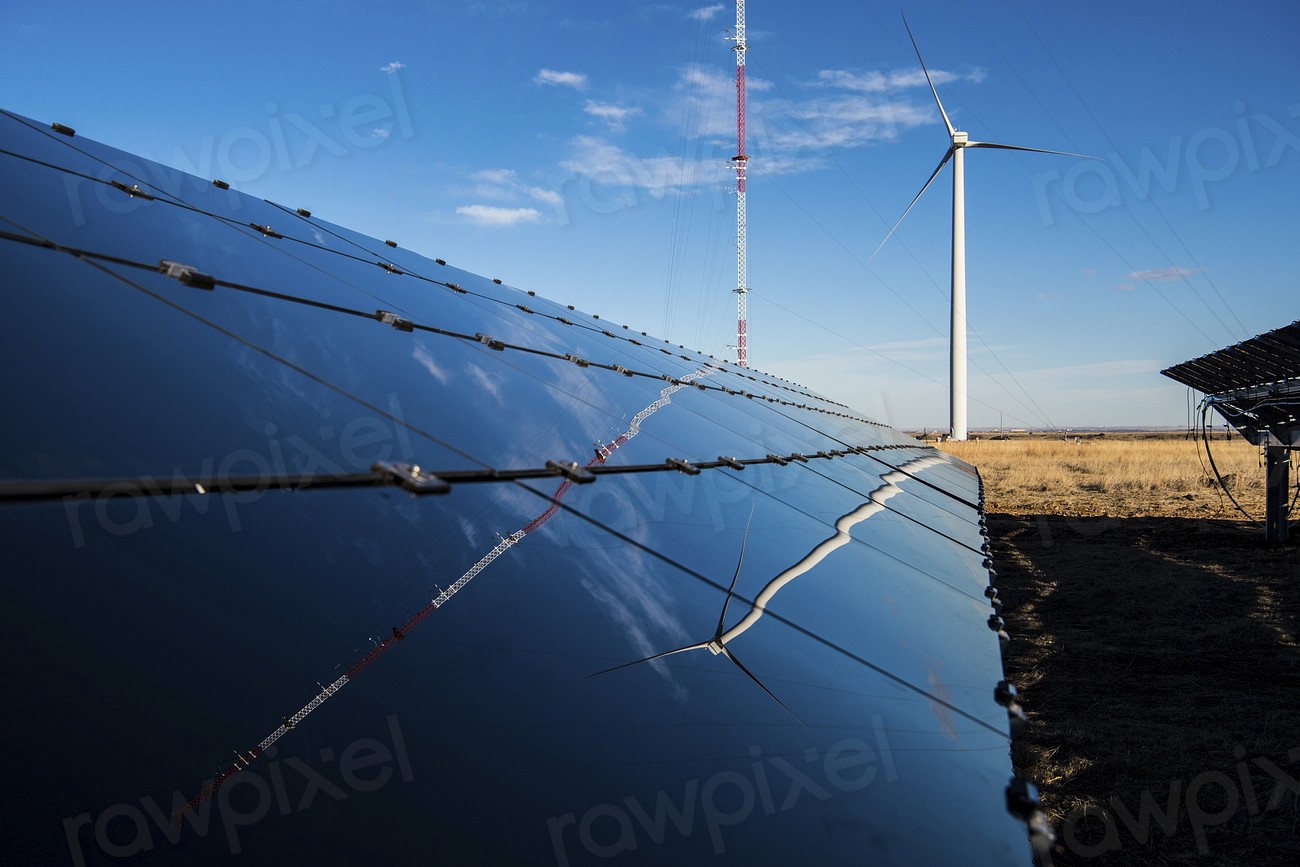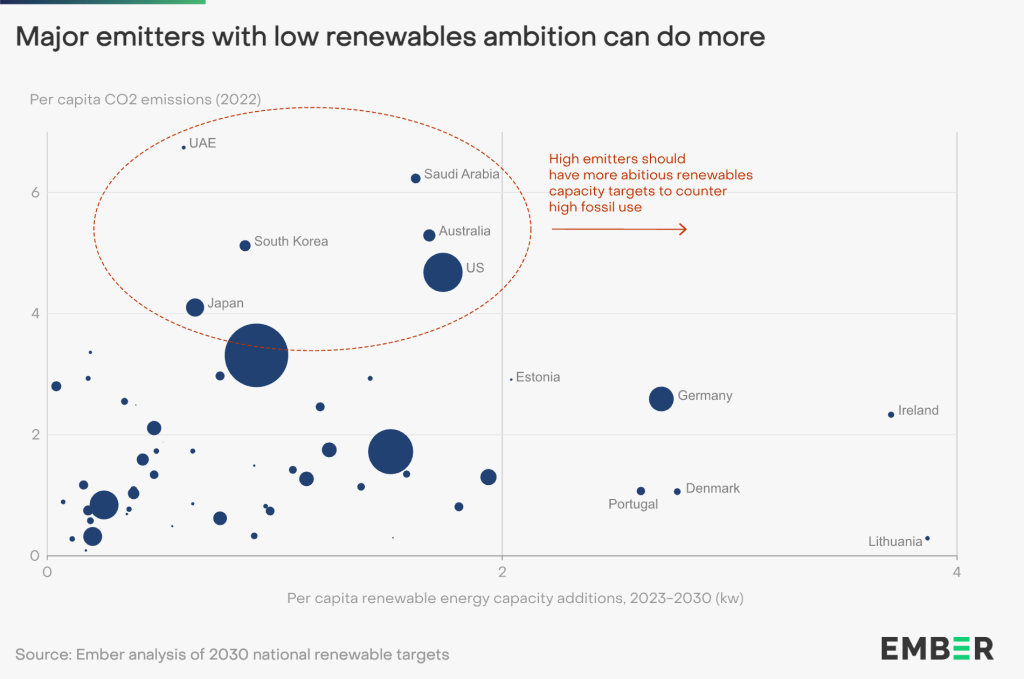
Governments plan to double renewable capacity by 2030, and tripling is within sight, according to a newly released report.
Many countries are already on track to exceed their national targets, and more ambition is achievable to bring a tripling of global renewables within reach, according to an analysis of national targets by energy think tank Ember.
The report analyzes renewables targets for 57 countries, plus the EU, that collectively represent 90% of global power sector emissions. According to these targets, global renewable capacity will reach an estimated 7.3 terawatts (TW) in 2030, more than doubling from 3.4 TW in 2022. More than 75% of renewable capacity in 2030, where stated, will be from solar and wind.
However, the current renewables boom is already outpacing governments’ planned growth. The world could achieve a doubling just by continuing the deployment achieved in 2023 throughout the rest of the decade – yet all signs point to a more rapid growth curve.
If the countries analyzed by Ember continue the growth rate of 17% achieved since 2016 throughout the rest of this decade, it would put the world on track for a tripling of renewables.
The renewables revolution
This year was another record year for renewables, with the International Energy Agency (IEA) forecasting 500 gigawatts (GW) of additions in 2023, up 71% from 2022. More solar was installed in 2023 than the US’s entire renewable capacity. This was enabled by an even faster increase in the manufacturing capacity of solar panels, which doubled in just two years and is expected to exceed 1,000 GW in 2024.

Ember found that current national targets don’t account for this recent acceleration of renewables. Twenty-two countries already have enough renewable energy projects in development to exceed their 2030 target, and a further 12 countries are already building renewables faster than required to meet their 2030 target. That includes Brazil, which is set to install almost three times more renewable capacity in 2023 than it aims to build each year until 2030.
“The targets of today are already outdated and should be updated,” said Ember’s global analyst Dr Katye Altieri. “Governments have yet to understand the revolution that’s under way with renewables. As we approach COP28, leaders should be confident in supporting a global goal to triple renewables; it is looking more possible than ever to achieve.”
How to triple renewable capacity
Building on evidence from the IEA and IRENA, the COP28 president has called for a global agreement to triple renewable capacity by 2030. Ember’s analysts have identified a gap of 3.7 TW between collective national targets and a global tripling (11 TW) that must be made up through accelerated deployment and increased ambition.
Some countries have ambitious targets in place: 10 countries, including India, already aim to triple their renewable capacity. Twelve countries have wind and solar share targets that exceed the global goal of 40% by 2030, including the US – the world’s second-largest emitter. A further 20 countries plan to shift more than 20% of their electricity mix from fossil fuels to renewables by 2030, including South Africa.

However, the report highlights particular countries that must step up their targets, including Australia, Japan, South Korea, and the United Arab Emirates, which are already on track to exceed their targets and are among the world’s highest power sector emitters per capita.
“Tripling renewable capacity worldwide is the single biggest action required this decade for the climate,” continued Altieri. “This goal is within sight if governments set targets that reflect the current pace of change and roll out robust new policies to supercharge the building of solar and wind power.”
Electrek’s Take
To put it succinctly, Ember’s report is saying, “Knuckle down, world, you can do this.” And the UN Environment Programme (UNEP) today drove home – once again – why the transition to fossil fuels must be undertaken urgently.
UNEP’s “Emissions Gap Report 2023,” released today, finds that current pledges under the Paris Agreement put the world on track for a 2.5-2.9C temperature rise above pre-industrial levels this century – and thus the urgent need for increased climate action.
I’m amused (I like black humor) by the double-entendre title of this year’s report – “Broken Record.” It refers to 2023’s record-breaking temperatures and weather events. It also refers to UNEP saying the same thing over and over again, yet governments aren’t responding quickly enough.
UNEP states in its executive summary that the world needs to cut 2030 emissions by 28% to get on a least-cost pathway for the 2C goal of the Paris Agreement and 42% for the 1.5C goal. But it details over-compliance:
Over-complying with current [Nationally Determined Contribution] targets for 2030 will enable countries to put forward more ambitious mitigation targets for 2035 in their next NDCs, and it will make the realization of such ambitious targets for 2035 more feasible.
Ember just proved that tripling renewables capacity can be done. The findings in UNEP’s report prove that it must be done.
Read more: For the first time ever, the IEA predicts that global emissions will peak by 2025
Photo: First Solar, a NREL research by U.S. Department of Energy is licensed under CC-CC0 1.0; Charts: Ember
To limit power outages and make your home more resilient, consider going solar with a battery storage system. In order to find a trusted, reliable solar installer near you that offers competitive pricing, check out EnergySage, a free service that makes it easy for you to go solar. They have hundreds of pre-vetted solar installers competing for your business, ensuring you get high-quality solutions and save 20-30% compared to going it alone. Plus, it’s free to use, and you won’t get sales calls until you select an installer and share your phone number with them.
Your personalized solar quotes are easy to compare online, and you’ll get access to unbiased Energy Advisers to help you every step of the way. Get started here. – ad*
FTC: We use income earning auto affiliate links. More.





Comments